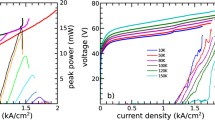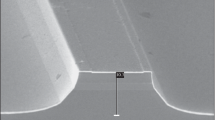Abstract
Temperature dependent Quantum Cascade Lasers are known for their advantages when compared to conventional lasers. In this work, we will focus on their temperature dependent capabilities. This research work reports the impact of optical device parameters on the transient and steady state dynamics of the device. Also, analysis on the analog modulation characteristics on the device is carried out in detail. The parameters namely terminal voltage (V), spontaneous emission factor (β), number of stages (M) and mirror reflectivity (R) are varied under different cold finger temperature conditions to evaluate their effect on the device characteristics. Bandwidth, maximum modulation depth, and corresponding frequency are investigated while the device is being powered by a haversine input current. From the analysis, it is found that as the cold finger temperature is increased, the lasing action is delayed leading to increase in threshold current irrespective of variation in any device parameter. Also, maximum Modulation Depth (MD) of 18% is obtained when T = 45 K and driven with 0.65 A current. When the injected current is 1.05 A at T = 15 K, maximum bandwidth of 27 GHz is produced. The minimum frequency to produce maximum MD increases with increase in current and cold finger temperatures.








Similar content being viewed by others
Data and materials availability
Data sharing not applicable to this article as no datasets were generated or analyzed during the current study.
References
Agnew, G., et al.: Efficient prediction of terahertz quantum cascade laser dynamics from steady-state simulations. Appl. Phys. Lett. 106(16), 161105 (2015)
Alqahtani, A.S., Kumar, U.A., Ramakrishnan, J., et al.: Investigation of hybrid spectrum slicing-wavelength division multiplexing (SS-WDM) in transparent medium for mode division multiplexing applications. Opt. Quant. Electron. 55, 243 (2023). https://doi.org/10.1007/s11082-022-04518-6
Arafin, M.T., Islam, N., Roy, S., et al.: Performance optimization for terahertz quantum cascade laser at higher temperature using genetic algorithm. Opt. Quant. Electron. 44, 701–715 (2012). https://doi.org/10.1007/s11082-012-9590-z
Ashok, P., Ganesh Madhan, M.: Effect of device parameters on gain switching in quantum cascade lasers. Laser Phys. Lett. 16, 1–6 (2019a)
Ashok, P., Ganesh Madhan, M.: Performance analysis of various pulse modulation schemes for a FSO link employing gain switched quantum cascade lasers. J. Opt. Laser Technol. 111, 358–371 (2019b)
Ashok, P., Ganesh Madhan, M.: Effect of cold finger temperature on optical pulse modulation characteristics in a 2.59 terahertz quantum cascade laser. Laser Phys. Lett. 17, 1–7 (2020a)
Ashok, P., Ganesh Madhan, M.: Numerical analysis on capacity improvement in free space optical link employing two-segment quantum cascade laser-based repeater. Optik 204, 164216 (2020b)
Ashok, P., Ganesh Madhan, M.: Performance evaluation of free space optical link by incorporating the device parameters of quantum cascade laser-based transmitter. Laser Phys. Lett. 18, 1–6 (2021a)
Ashok, P., Ganesh Madhan, M.: Impedance characteristics of mid infra-red quantum cascade lasers. J. Opt. Laser Technol. 134, 106662 (2021b)
Ashok, P., Ganesh Madhan, M., Deepiha, P., Rimmya, C., Piramasubramanian, S.: An efficient chaotic optical signal generation scheme using gain lever effect in bi-section laser diodes. Opt. Commun. 475, 126202 (2020)
Bai, J., Citrin, D.S.: Design of nonlinearity-enhanced quantum-cascade lasers. Opt. Quant. Electron. 40, 191–195 (2008). https://doi.org/10.1007/s11082-007-9172-7
Fathololoumi, S., Dupont, E., Chan, C.W.I., Wasilewski, Z.R., Laframboise, S.R., Ban, D., Matyas, A., Jirauschek, C., Hu, Q., Liu, H.C.: Terahertz quantum cascade lasers operating up to 200 K with optimized oscillator strength and improved injection tunneling. Opt. Express 20, 3866–3876 (2012)
Gopinath, S., Ashok, P., Ganesh Madhan, M.: Performance evaluation of free space optical link driven by gain switched temperature dependent quantum cascade lasers. Laser Phys. Lett. 18, 1–6 (2021)
Han, M., et al.: Long-wave infrared discrete multitone free-space transmission using a 9.15-μm quantum cascade laser. IEEE Photon. Technol. Lett. 35(9), 489–492 (2023). https://doi.org/10.1109/LPT.2023.3257843
Hu, Y., Liu, F., Wang, L., et al.: Broad area single mode operation of quantum cascade lasers by integrating porous waveguide and distributed feedback grating. Opt. Quant. Electron. 47, 515–521 (2015). https://doi.org/10.1007/s11082-014-9886-2
Jirauschek, C., Tzenov, P.: Self-consistent simulations of quantum cascade laser structures for frequency comb generation. Opt. Quant. Electron. 49, 414 (2017). https://doi.org/10.1007/s11082-017-1253-7
Joharifar, M., et al.: High-speed 9.6-μm long-wave infrared free-space transmission with a directly-modulated QCL and a fully-passive QCD. J. Lightwave Technol. 41(4), 1087–1094 (2023). https://doi.org/10.1109/JLT.2022.3207010
Kamruzzaman, M.M., Mhatli, S., Arun Kumar, U., et al.: Design of circular photonic crystal fiber for OAM extraction SDM applications. Opt. Quant. Electron. 54, 864 (2022). https://doi.org/10.1007/s11082-022-04251-0
Kim, D., Curwen, C.A., Wu, Y., Reno, J.L., Addamane, S.J., Williams, B.S.: Wavelength scaling of widely-tunable terahertz quantum-cascade metasurface lasers. IEEE J. Microw. 3(1), 305–318 (2023). https://doi.org/10.1109/JMW.2022.3224640
Krishna, K., Madhan, M., Ashok, P.: Study of gain switching in vertical cavity surface emitting laser under different electrical pulse inputs. Def. Sci. J. 70(5), 538–541 (2020)
Kruck, P., Page, H., Sirtori, C., Barbieri, S., Stellmacher, M., Nagle, J.: Improved temperature performance of Al0.33Ga0.67As/GaAs quantum-cascade lasers with emission wavelength at λ≈11 μm. Appl. Phys. Lett. 76, 3340–3342 (2000)
Li, W., et al.: High-power terahertz quantum cascade lasers based on high-Al-composition four quantum wells. IEEE Photon. Technol. Lett. 34(13), 671–674 (2022). https://doi.org/10.1109/LPT.2022.3181242
Murali Krishna, K., Ganesh Madhan, M., Ashok, P.: Simulation studies on polarization modulated vertical cavity surface emitting laser for combined fiber and free space optical links. Optik 219, 165018 (2020)
Page, H., Kruck, P., Barbieri, S., Sirtori, C., Stellmacher, M., Nagle, J.: High peak power (1.1 W) (Al) GaAs quantum cascade laser emitting at 9.7 µm. Electron. Lett. 35, 1848–1849 (1999)
Page, H., Becker, C., Robertson, A., Glastre, G., Ortiz, V., Sirtori, C.: 300 K operation of a GaAs-based quantum-cascade laser at k 9 lm. Appl. Phys. Lett. 78, 3529–3531 (2001)
Slivken, S., Razeghi, M.: High power, room temperature InP-based quantum cascade laser grown on Si. IEEE J. Quant. Electron. 58(6), 1–6 (2022). https://doi.org/10.1109/JQE.2022.3212052
Winge, D.O., Wacker, A.: Temperature dependent nonlinear response of quantum cascade structures. Opt. Quant. Electron. 46, 533–539 (2014). https://doi.org/10.1007/s11082-013-9779-9
Acknowledgements
The authors certify that this material or similar material has not been and will not be submitted to or published in any other publication before. Furthermore, the authors certify that they have participated sufficiently in the work to take public responsibility for the content, including participation in the concept, design, analysis, writing, or revision of the manuscript.
Funding
The authors are thankful to the Deanship of Scientific Research at Najran University for funding this work under the Research Groups Funding program grant code (NU/RG/SERC/12/1).
Author information
Authors and Affiliations
Contributions
All authors contributed to the study conception and design. AHMA and RRB have done the analysis of the article. TA and AP have experienced the results with proper optimization. AP and RCR has validated the complete work and prepared the first draft of the manuscript. All authors commented on previous versions of the manuscript. All authors read and approved the final manuscript.
Corresponding author
Ethics declarations
Conflict of interest
The authors declares that they do not have any competing interest. The authors of this research acknowledge that they are not involved in any financial interest.
Ethics approval and consent to participate
Not Applicable.
Consent for publication
Not Applicable.
Additional information
Publisher's Note
Springer Nature remains neutral with regard to jurisdictional claims in published maps and institutional affiliations.
Rights and permissions
Springer Nature or its licensor (e.g. a society or other partner) holds exclusive rights to this article under a publishing agreement with the author(s) or other rightsholder(s); author self-archiving of the accepted manuscript version of this article is solely governed by the terms of such publishing agreement and applicable law.
About this article
Cite this article
Almawgani, A.H.M., Reddy, B.R., Alsuwian, T. et al. Impact of optical device parameters on the performance characteristics of temperature dependent quantum cascade lasers. Opt Quant Electron 55, 929 (2023). https://doi.org/10.1007/s11082-023-05197-7
Received:
Accepted:
Published:
DOI: https://doi.org/10.1007/s11082-023-05197-7




